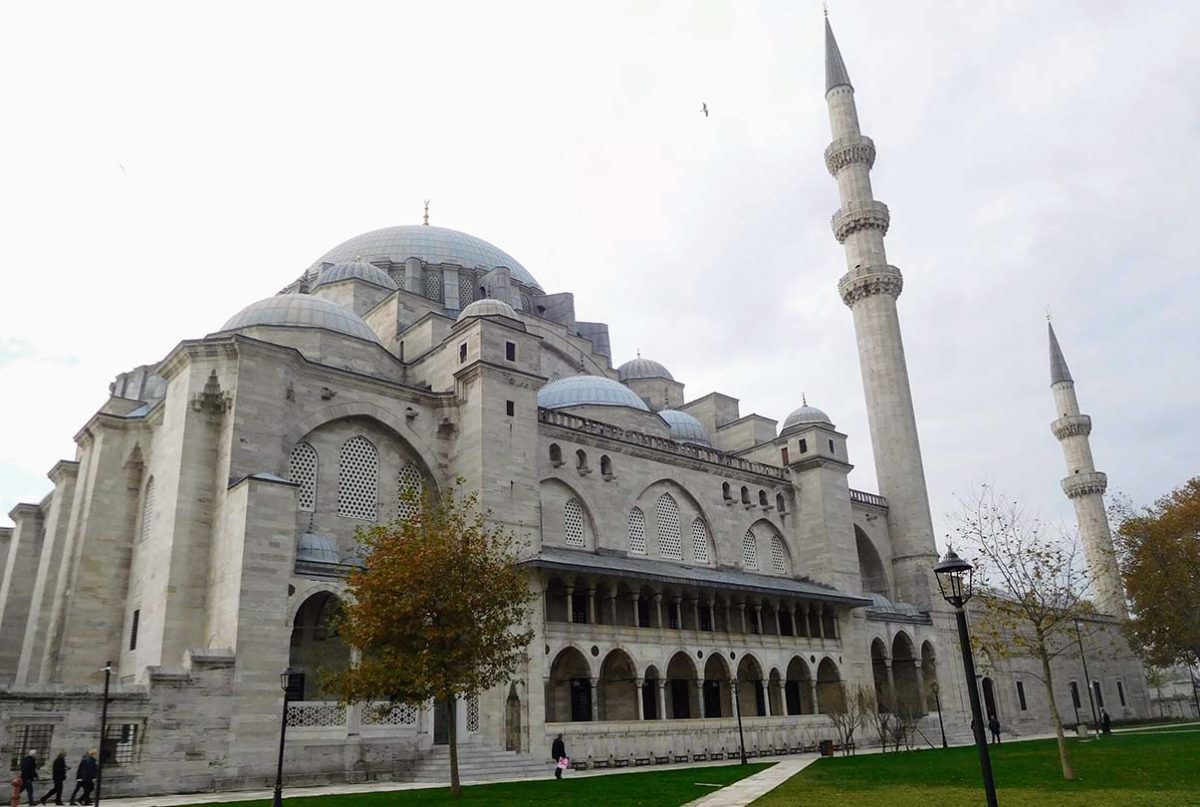
by Elizabeth von Pier
Ninety-eight percent of the population of Turkey is Muslim, so it is not surprising that there are thousands of beautiful mosques in Istanbul. Some are among the biggest and best in the world, and some are tiny with awesome settings on the Bosphorus.
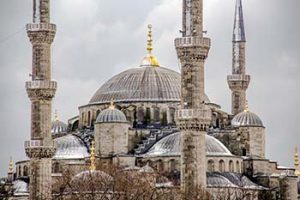 Four, in particular, stand out to me. All are on the European side of Istanbul. The Sultan Ahmed Mosque, also known as the Blue Mosque, is the most famous and is known for the color of the tiles that decorate much of the interior. The Hagia Sophia is in the old city next to the Blue Mosque and, although it is a museum today, it has been used for centuries as both a Christian church and a mosque. The Suleymanye Mosque with its lovely understated interior is the largest and is located high on a hill overlooking the Golden Horn. And the pint-sized Ortakoy Mecidiye Mosque sits right on the shores of the Bosphorus in the trendy Besiktas district.
Four, in particular, stand out to me. All are on the European side of Istanbul. The Sultan Ahmed Mosque, also known as the Blue Mosque, is the most famous and is known for the color of the tiles that decorate much of the interior. The Hagia Sophia is in the old city next to the Blue Mosque and, although it is a museum today, it has been used for centuries as both a Christian church and a mosque. The Suleymanye Mosque with its lovely understated interior is the largest and is located high on a hill overlooking the Golden Horn. And the pint-sized Ortakoy Mecidiye Mosque sits right on the shores of the Bosphorus in the trendy Besiktas district.
All welcome non-Muslims as long as you are properly clothed and adhere to some basic tenets of propriety.
Ten Things You Need to Know About Visiting a Mosque
 Here are some of the most important things that I learned about visiting religious sites in a Muslim country.
Here are some of the most important things that I learned about visiting religious sites in a Muslim country.
1. Muslims are called to pray five times a day so that they are frequently reminded of Allah and have opportunities to seek His guidance and forgiveness. The exact time changes daily based on the rotation of the earth around the sun.
2. During prayer times, mosques are generally closed to tourists so that the faithful have privacy during their commune with Allah. You can take this opportunity to visit the property surrounding the mosque including the tomb of the sultan and his wives.
3. Men and women offer their prayers in separate spaces. Men kneel on the carpet in the main hall. The women’s space is smaller than the men’s and is set aside behind a partition in the back. Some say this is so that the men don’t get distracted during prayer; others say it represents a special honor to women.
4. There are no chairs, benches or pews in a mosque. Everyone from all walks of life sits on the floor to symbolize their equality in front of Allah.
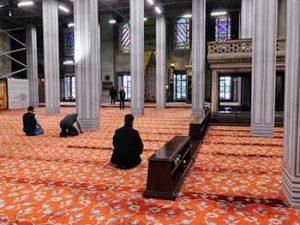 5. It is necessary to take off your shoes when entering a mosque in recognition that you are entering a holy place. This also keeps the prayer space clean for the act of prostration during which the supplicant puts his forehead and nose on the ground as he/she prays.
5. It is necessary to take off your shoes when entering a mosque in recognition that you are entering a holy place. This also keeps the prayer space clean for the act of prostration during which the supplicant puts his forehead and nose on the ground as he/she prays.
6. Women must cover their hair and shoulders before entering a mosque. This is because hair is considered to be part of a woman’s sexuality that should be revealed only to her husband.
7. Men must be dressed respectfully. Long pants and collared shirts with sleeves are appropriate.
8. Generally, it is permitted to take photographs inside a mosque. It is a sign of respect to avoid photographing Muslim women and people who are praying.
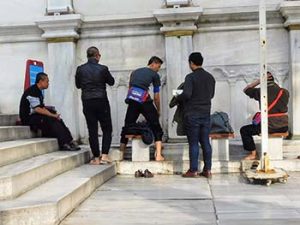 9. Ablution, the act of cleansing oneself before praying to Allah, is a prerequisite to praying so that one is both pure spiritually and clean physically. Ablution facilities typically include a row of faucets and stone stools on the side of the building used by the men. The women’s area is hidden from public view. Commonly used parts of the body are washed before entering the prayer hall.
9. Ablution, the act of cleansing oneself before praying to Allah, is a prerequisite to praying so that one is both pure spiritually and clean physically. Ablution facilities typically include a row of faucets and stone stools on the side of the building used by the men. The women’s area is hidden from public view. Commonly used parts of the body are washed before entering the prayer hall.
10. Inside a mosque, you will find calligraphy rather than statues and paintings of God and saints like you would find in a church. This is because Muslims worship an unseen God and believe that it is impossible to know what He looks like. So instead of depictions of Mohammed or the prophets, you will find calligraphy of Qur’anic verses and prayers.
With this knowledge, you are now ready to visit some of the best mosques of Istanbul.
The Sultan Ahmed (Blue) Mosque
The Sultan Ahmed Mosque is also called the Blue Mosque for the color of the blue, green, and turquoise tiles that cover the interior. It is considered to be one of the most magnificent buildings in Turkey. Constructed between 1609 and 1617 during the rule of Ottoman Sultan Ahmed I, the mosque was built to reassert Ottoman power following losses suffered in the war with Persia in 1603-1618. Sultan Ahmed I was only 19 years old when he commissioned the building of this great mosque and he showed his dedication to its construction by personally working as a laborer.
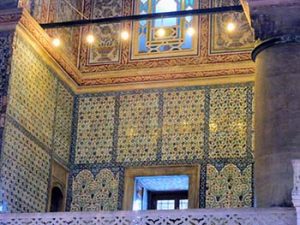 Mosques typically have two or four minarets but you will notice that the Blue Mosque has six. Some say that this was to flaunt Ahmed I’s power and wealth. When he was criticized because the mosque in the holy city of Mecca also had six minarets, Ahmed ordered that a seventh minaret be added to the mosque in Mecca.
Mosques typically have two or four minarets but you will notice that the Blue Mosque has six. Some say that this was to flaunt Ahmed I’s power and wealth. When he was criticized because the mosque in the holy city of Mecca also had six minarets, Ahmed ordered that a seventh minaret be added to the mosque in Mecca.
Twenty-one thousand blue tiles cover the interior of the Blue Mosque. They are Iznik tiles from western Anatolia, hand-painted in florals and geometrics. There also are 260 stained-glass windows, impressive displays of Arabic calligraphy on the walls, and a large chandelier that hangs low over the prayer hall.
Suleymanye Mosque
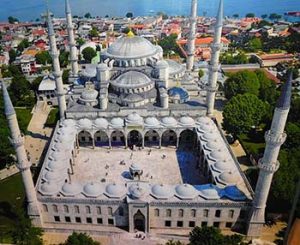 This classical masterpiece of the golden age of the Ottoman empire is decorated more simply. It was commissioned by Sultan Suleiman the Magnificent who ruled the Ottoman Empire for 46 years and was one of the most important sultans of the 16thаcentury. Construction work started in 1550 and was finished in 1557. The Suleymanye Mosque is considered to be a highlight of Ottoman architecture. In fact, the glass work of the windows is so superb that the artists felt it had reached the ultimate perfection and beauty and did not dare to produce glass work for the Ottomans again.
This classical masterpiece of the golden age of the Ottoman empire is decorated more simply. It was commissioned by Sultan Suleiman the Magnificent who ruled the Ottoman Empire for 46 years and was one of the most important sultans of the 16thаcentury. Construction work started in 1550 and was finished in 1557. The Suleymanye Mosque is considered to be a highlight of Ottoman architecture. In fact, the glass work of the windows is so superb that the artists felt it had reached the ultimate perfection and beauty and did not dare to produce glass work for the Ottomans again.
The mosque building itself has four minarets at the corners. The interior is visually stunning with tile work in understated pink and white, Qur’anic calligraphy in gold on black, a large low chandelier over the prayer area, and a magnificent dome that spans the entire interior and is supported by four pillars. Lots of light comes in and there is an aura of tranquility.
The mosque complex is situated on 2.4 acres on the Golden Horn and shores of the Bosphorus. Views of the Galata district and Taksim, the modern district, from the gardens and terrace are awe-inspiring. It is at the top of the highest of the seven hills of Istanbul’s old city.
Hagia Sophia
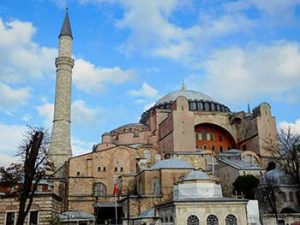 While not a mosque today, I have included Hagia Sophia because it served as a mosque for nearly 500 years. It is Istanbul’s top tourist attraction. Hagia Sophia is almost 1500 years old and has a very interesting history. It was built as a Byzantine church in 532 AD by Emperor Justinian I and was used as a church for 916 years. In 1453 when the Ottomans captured Constantinople, it was converted into a mosque. And in 1935, nearly 500 years later, it became a museum.
While not a mosque today, I have included Hagia Sophia because it served as a mosque for nearly 500 years. It is Istanbul’s top tourist attraction. Hagia Sophia is almost 1500 years old and has a very interesting history. It was built as a Byzantine church in 532 AD by Emperor Justinian I and was used as a church for 916 years. In 1453 when the Ottomans captured Constantinople, it was converted into a mosque. And in 1935, nearly 500 years later, it became a museum.
Hagia Sophia is a blend of east and west, with elements of both the Byzantine and Ottoman empires. It is considered to be the finest house of worship in the Christian and Muslim worlds. The crowning achievement is the vast central dome.
It took five years to build Hagia Sophia and drained the treasury in the process. Emperor Justinian had asked for a church with grand proportions that would last for centuries and keep his name alive. He got his wishЧHagia Sophia is still standing after 15 centuries and Paris’ Notre Dame would fit within its great dome.
When the building became a mosque in 1453, the church’s mosaics and frescoes depicting God and people were covered over with whitewash and plaster since this is not allowed in a mosque. These are in the process of being restored. You can get an up-close view of the most famous if you take the stairs and walkway to the upper floor galleries. The Ottomans added the Arabic calligraphy that you see in the large round medallions.
Ortokoy (Mecidiye) Mosque
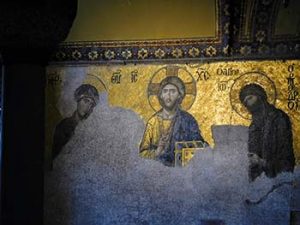 This little mosque in the Besiktas district north of the old city is tiny and serene, and has one of the nicest settings in the trendy Ortokoy pier area overlooking the Bosphorus and the Asian side of Istanbul.
This little mosque in the Besiktas district north of the old city is tiny and serene, and has one of the nicest settings in the trendy Ortokoy pier area overlooking the Bosphorus and the Asian side of Istanbul.
Commissioned by Ottoman Sultan Abdulmecid and built between 1854 and 1856, it is the newest of the four mosques described here. It was designed by an Armenian father and son who also designed the Dolmabahce Palace and mosque just up the road. It has two minarets and the pink and white interior has lovely glass chandeliers and Arabic calligraphy which was executed by the Sultan himself, a master calligrapher. It is light and bright inside due to the large windows which allow light from the outside and reflections off the water to flood in.
After visiting the mosque, be sure to try Ortokoy’s popular street food, аkumpir, which are overstuffed baked potatoes.
If You Go:
Hotel Amira, Kucuk Ayasofya Mahallesi Mustafapasa Sokak No 43, Sultanahmet 34122 Istanbul, Turkey, аinfo@hotelamira.com
Sultan Ahmed Mosque (Blue Mosque), Sultanahmet, Sultanahmet Mah. 34122/Istanbul
Süleymaniye Mosque, Sinan Aga Mah. Zeyrek Cad. No:4, Zeyrek/Fatih/Istanbul
Hagia Sophia, Sultanahmet Mh., Ayasofya Meydani, Fatih, Istanbul, +90 212 522 1750, open daily except Mondays
Ortakoy Mosque, Mecidiye Mah. Cami Sok. No:2, Ortakoy, Besiktas, Istanbul
Elizabeth von Pier loves to travel. After she retired from her lifetime career in banking, she has been traveling the world, photographing, and writing. She has been published in the Los Angeles Times, In the Know Traveler, GoNomad, Wave Journey, Hackwriters, Travelmag, The Independent Spirit, and Travel Thru History. She also has recently published her first book, Where to Find Peace and Quiet in London. Ms. von Pier lives in Hingham, MA.
All photos are by Elizabeth von Pier.

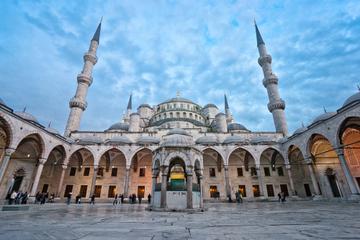
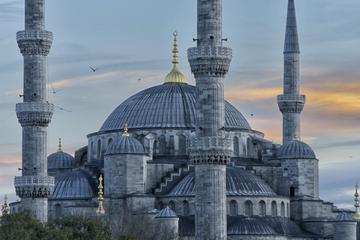



Leave a Reply
You must be logged in to post a comment.